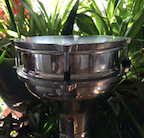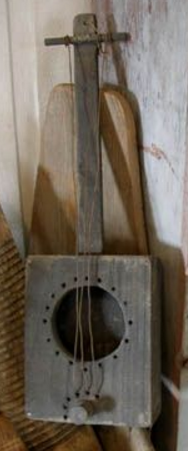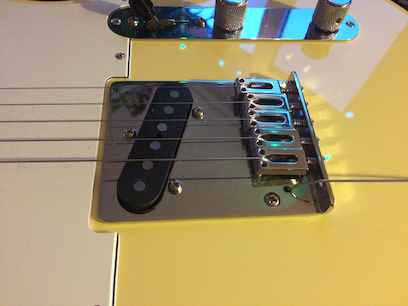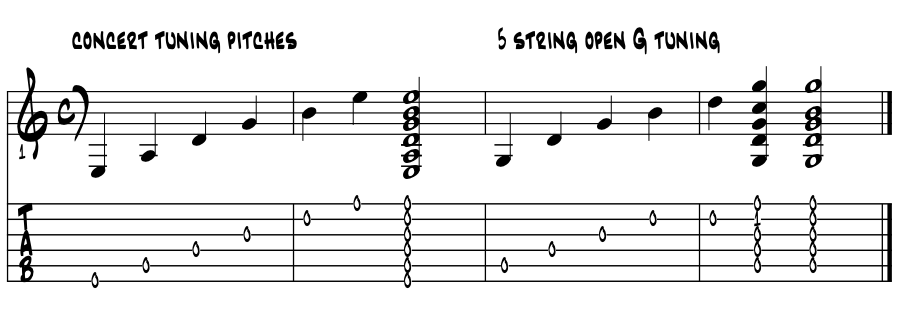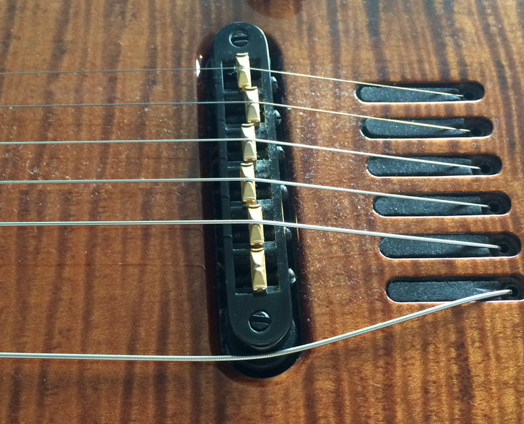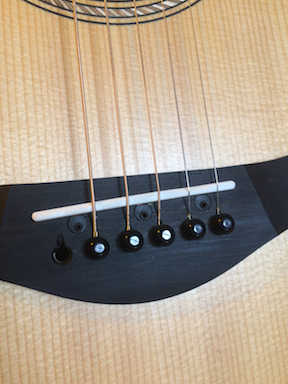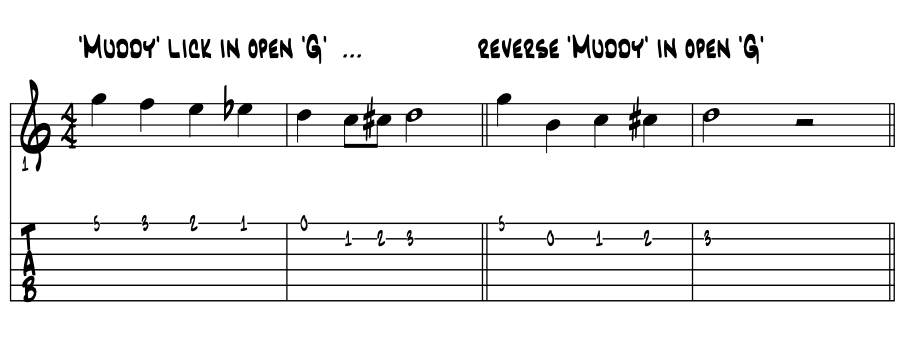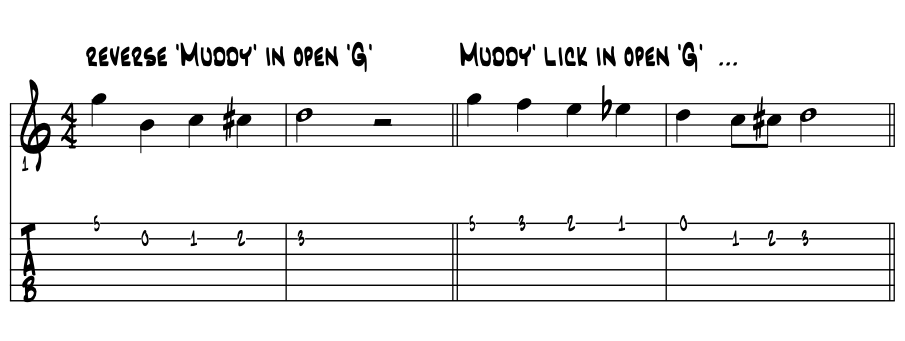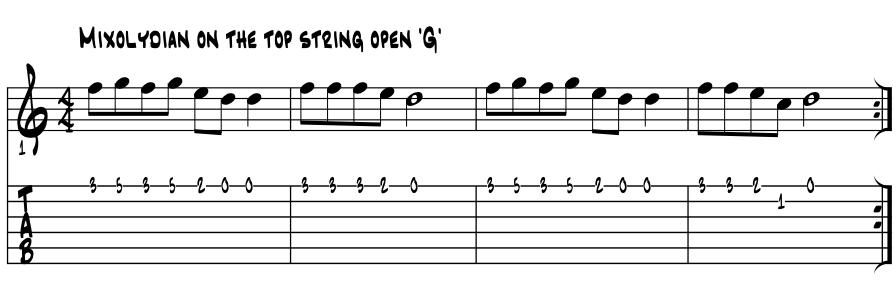~ six string guitar swaps for five / four string banjo ~ ~ a blues guitar primer in open 'G' tuning ~ ~ * G D G B D ~ ~ easiest capture of pure blue notes ~ ~ built in Mixolydian colors open strings ~ ~ Rolling Stones global hits in open 'G' ~ ~ an ancient shape rides again ~ ~ it's a new dawn in open G ~
|
Nutshell / open 'G' early blues ~ banjo tuning. Into the waybac in more ways than one here. Just turns out that some of our near present day rockin' classics roll off our guitars with an ease that can oftentimes be kind of stunning. Sounds crazy yea but working out some blues in open 'G' tuning can be transformative; both historically, by getting us to a core Americana root of the banjo and artistically, as the early blues 'open G' tuning coolness jumps right off the banjo and on to the Tele fingerboard, when a six string guitar is tuned to an open 'G' chord. And if you've already got some git under your fingers, a potential super kaboom awaits with just a slight twisting of the pegs. Once up and running in an open 'delta' styled tuning such as 'open G', as once employed by originalist blues artist Robert Johnson, add in any sort of workable slide for finding pitches, and music of waybac then seems to just kick right on in, and off we go back through the history of our guitar sounds towards the origins of the Americana blues, probably first sounded on a rig like this in the early 1800's or so. For some artists, whole musical songwriting careers (on guitar) happen using guitars with 'open' tunings; a there's many to choose from. So while there's many ways to twist up the pegs and find open tuning coolness, in the following discussions it is the 'open G' tuned pitches that tie it all together for us; early blues with today's modern harmony. So with just a few twists of the tuning pegs today, we get to go back back in time to when an 'old banjo', like the one pictured, motored things along at the local jam sessions :) |
|
Might only need five strings. In moving from standard to open 'G', we really only need five string, the low 'E' string will usually goes away. This is cool as it now makes our bass string, the 5th string, the root of the chord, 'G.' This just makes it easier to both thump along on the bottom and find our way up and down the neck. Knowing that three of the four traditional fret marker dots essential to the blues built right in, bass lines are built right in. Six strings works too and has its advantages too; easy to 'bounce the Five' on the open #5 and #6 bass strings. Using standard notation, our open 'G' tuning moves look like this. Example 1. |
Cool? Now, a full strumming of the open strings sounds a big 'G' triad / chord. We get two roots 'G', a major 3rd 'B', and three perfect 5th's, 'D.' Jamm on the open 'G' for a spell, giving your 'motor' hand a bit of a free run of it, maybe find a gallop rhythm or two. |
Jammin' the bar. Now that the open strings create a chord, working the barre index finger or a slide from the open to the 3rd then 5th fret should start bring some blue. Working down from the 12th fret, an octave above the open strings, starts us on descending runs that easily end with the open strings. Find a mojo lick of your own and write yourself a 'modal' blues tune to mark the occasion. |
In 'open G tuning', guitar equals banjo. That the same licks discovered on guitar here will also work on near any old banjo is beyond just being a bonus. That we get the one and two finger banjo chords and easy slide potentials, makes it a winning trifecta plus; a good perspective to own as the open 'G' tuning in our Americana musics goes back to the very beginnings of our tale (legend tells us that Jerry started on banjo) . |
|
'Tele' five string and Rolling Stones' hit songs. And since banjos usually have four or five strings, our low 6th string on guitars is not really necessary. Make any six sting guitar into five by removing the low 'E' string. This is the method employed by Euro rocker Keith Richards to electric effect. Example 1a. |
|
Rolling Stones global hit radio songs. Check out the Stones' radio hits "Happy", "You Can't Always Get What You Want", "Start Me Up' and get four cool dance tunes that everyone knows under the fingers with all the same two or three movable barre chord shapes, barre chords on an electric, imagine that. Add in the acoustic crossover ballad "Wild Horses" to back your vocals with open 'G' in a not so blues, more diatonic setting / chord progression etc. And once our ax is tuned to open 'G', lifting the rock songs off the record is a snap. And if the stars align at some point, we maybe get to make the 'big roar' rockin' the changes of these songs. Open 'G' Mixo has the magics, old as the hills now and a pure blues mine for licks. |
|
Some blues origins history. Luckily in these studies of our blues musics, we've a clear tie to its historical roots through how we tune up the pitches. For back in early days America, we know our blues musical ancestors played four and five string banjos, and while they most likely tuned them various ways, this 'open G' sequence of the pitches was the one most everyone knew so it seems. For even 100 years later, when cats started recording music on wax, the open 'G' pitches come right on through pure, pure and pure blue. Search and find the recordings. |
Along around the 1800's, the Spanish guitar, with its six strings, made its way up north into Texas and eventually all points USA beyond. Its six strings were tuned in Euro 'concert E', today our cool standard tuning, so enough of a difference to throw banjo players off a bit as to where the pitches are located. Compare the tunings. Example 2. |
So maybe we've got an extra string now, that the low 'E' might get in the way? Just figure out your own easy way to deal with it as you'll probably want it back at some point, though maybe not after ya dig the magic to follow. So, take the string off maybe? Or tune it down to 'D', or way loosen it and tape it out of the way. I just way loosen mine and push it around the edge of the bridge. Easy.
|
|
So now that we've got our strings tuned up to sound a very bright, tight and oh so cool open chord, what's the benefits of such an earthly arrangements? And what do we lose ? Well first to the gains and all this coolness :) |
The 'Muddy' lick. Here's a new beginning for us in open 'G', the handful of pitches that sets the whole Americana blues hue into motion and has now for a couple of hundred years or so. Got these under your fingers yet? Example 3. |
|
Reverse 'Muddy' lick. Jumped the line there a bit, here's the flip side of the last idea. Example 4. |
Rote memorize these last two ideas in a couple of keys. Now cliche and deep in our vocabulary, they really strengthen our sense of direction to an event in the music as well as getting everyone on the same page ASAP :) |
Mixolydian pops right out. Nice hammer-on right out of the gate sets the Mixolydian mode off and running. Very common riff here in open 'Gasconade idea even more so with some open strings added. Example 5 and 5a. |
The ease of which ... ya gotta love it. |
Easy core mojo lick. This next idea is pure banjo really, just pulling off on the notes located on the 3rd fret, moving from 3rd fret to open string, on each of the top four strings. Here with a banjo tone. Example 6. |
Exact same shapes, strings frets etc., yet on different gitfiddles makes for two unique ideas, now with a guitar tone ... just gotta love it. Example 6a. |
Again the ease of which ... gotta love it. |
First chords evolve. While there's many ways into this, we'll simply borrow the chord from the last idea to kick this off. Get a banjo book for more chord shapes and ideas. This first riff is an early blues rock cliche. First banjo tone then guitar. Example 7. |
Got a pedal to stomp on to bring the big roar ... ? Not that ya need it :) One finger barre ... hmmm ... could that become a slide ya think ? |
Make a 12 bar blues. Example 8.
|
Make a 12 bar blues with a slide. Example 9. |
|
Review and more. Cool with open 'G' tuning and the blues? While it's not for everyone, as nothing really is, for those hear the early Americana blues jump out from their git, it can be a super kaboom. As the licks jump out, learn them over on standard tuning to, by ear. |
